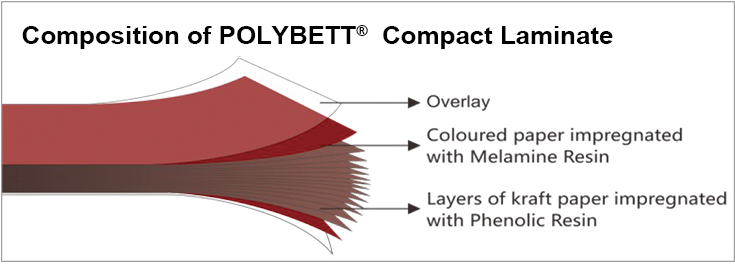In the world of interior design and construction, choosing the right materials for various applications is crucial. When it comes to surfacing materials, two popular options often come into consideration: high-pressure laminate (HPL) and compact laminate board. Both materials have their unique characteristics and offer distinct advantages. In this article, we will delve into the differences between high-pressure laminate and compact laminate board, exploring their features, applications, and benefits.
1. Introduction
When it comes to surfacing materials, high-pressure laminate and compact laminate board are widely used in residential and commercial projects. Understanding the differences between these two materials can help in making informed decisions when it comes to selecting the most suitable option for a particular application.
2. What is High-Pressure Laminate?
High-pressure laminate (HPL) is a versatile surfacing material made by combining multiple layers of kraft paper soaked in phenolic resin and a decorative layer impregnated with melamine resin. These layers are bonded together under high heat and pressure, resulting in a durable and robust sheet.

3. Advantages of High-Pressure Laminate
High-pressure laminate offers several advantages that make it a popular choice in various applications:
Durability:
HPL is known for its exceptional durability. It is resistant to scratches, impact, and abrasions, making it suitable for high-traffic areas.
Wide Range of Designs:
With HPL, you have an extensive selection of colors, patterns, and textures to choose from. It can mimic the appearance of natural materials like wood, stone, and metal, allowing for versatile design possibilities.
Easy Maintenance:
HPL surfaces are easy to clean and maintain. They are resistant to stains, moisture, and chemicals, ensuring long-lasting beauty with minimal effort.
Cost-Effective:
Compared to some other surfacing materials, high-pressure laminate is relatively affordable. It provides an excellent balance between cost and performance.
4. Applications of High-Pressure Laminate
High-pressure laminate finds applications in various settings, including:
Residential Interiors:
HPL is commonly used for kitchen countertops, cabinetry, furniture, and wall panels in homes. Its durability and design versatility make it a popular choice among homeowners.
Commercial Spaces:
In commercial settings such as offices, hotels, restaurants, and retail stores, HPL is widely used for surfaces that require durability and aesthetic appeal. It can be used for tabletops, reception desks, wall claddings, and restroom partitions.
Healthcare and Educational Facilities:
HPL's resistance to moisture and chemicals makes it suitable for healthcare and educational environments. It is often used for laboratory countertops, school furniture, and restroom partitions in these settings.
5. What is Compact Laminate Board?
Compact laminate board is another type of surfacing material that consists of multiple layers of kraft paper soaked in phenolic resin. Unlike high-pressure laminate, compact laminate board does not have a decorative layer. The focus of compact laminate board is on durability and strength.

6. Advantages of Compact Laminate Board
Compact laminate board offers several advantages that make it a preferred choice for certain applications:
Extreme Durability:
Compact laminate board is highly resistant to impact, scratches, and wear. It is a sturdy material that can withstand heavy use and abuse.
Moisture and Heat Resistance:
One of the standout features of compact laminate board is its excellent resistance to moisture and heat. It is highly suitable for environments where water exposure or high temperatures are common.
Hygienic Properties:
Compact laminate board has non-porous properties, making it resistant to bacteria, mold, and mildew growth. It is often used in applications where hygiene is a top priority.
Structural Stability:
Due to its construction and solid core, compact laminate board offers exceptional structural stability. It can be used in applications that require load-bearing capabilities.
7. Applications of Compact Laminate Board
Compact laminate board finds applications in various settings, including:
Public Restrooms:
Compact laminate board is commonly used for restroom partitions and vanity tops in public facilities. Its moisture resistance and durability make it ideal for high-traffic areas.
Laboratory Surfaces:
Due to its resistance to chemicals, compact laminate board is frequently used in laboratory settings. It is used for laboratory countertops, workstations, and other surfaces that require chemical resistance.
Outdoor Installations:
The weather-resistant properties of compact laminate board make it suitable for outdoor applications. It can be used for exterior cladding, wall panels, and outdoor furniture.
8. A Comparison of High-Pressure Laminate and Compact Laminate Board
When deciding between high-pressure laminate and compact laminate board, it's essential to consider the following factors:
Aesthetics:
High-pressure laminate offers a wider range of design options with its decorative layer, mimicking the appearance of various materials. Compact laminate board focuses more on durability and may have limited design choices.
Durability:
Both materials are highly durable, but compact laminate board excels in terms of impact resistance and structural stability. It is better suited for heavy-use environments.
Moisture Resistance:
While high-pressure laminate is moisture-resistant, compact laminate board has superior moisture resistance properties. It is an excellent choice for applications prone to water exposure.
Application Specifics:
Consider the specific requirements of your project. High-pressure laminate is versatile and suitable for a wide range of applications. Compact laminate board is ideal for areas that demand extreme durability, such as public facilities and laboratories.
9. Factors to Consider When Choosing Between HPL and Compact Laminate Board
When deciding between high-pressure laminate and compact laminate board, it's crucial to consider the following factors:
Purpose and Usage:
Identify the intended use of the surfacing material. Determine whether aesthetics, durability, moisture resistance, or other properties are of utmost importance.
Design Flexibility:
Consider the design options available with each material. If you require a broad range of colors, patterns, and textures, high-pressure laminate may be more suitable.
Budget:
Take into account the budget constraints of your project. High-pressure laminate generally offers a more cost-effective solution compared to compact laminate board.
Environmental Considerations:
If sustainability is a priority, research the environmental impact and certifications of both materials to make an eco-friendly choice.
10. Conclusion
In conclusion, both high-pressure laminate (HPL) and compact laminate board have their unique features and advantages. High-pressure laminate offers a wide range of design options, durability, and ease of maintenance, making it suitable for various residential and commercial applications. On the other hand, compact laminate board excels in extreme durability, moisture and heat resistance, and structural stability, making it ideal for areas with heavy use or exposure to water and high temperatures.
When choosing between HPL and compact laminate board, it is crucial to consider the specific requirements of your project, such as aesthetics, durability, moisture resistance, and budget. Evaluate the purpose and usage of the surfacing material and assess the design flexibility and environmental considerations. By carefully considering these factors, you can make an informed decision and select the most suitable option for your needs.
English
Русский
العربية
Français
Español
Português
Deutsch
italiano
日本語
한국어
Nederlands
Tiếng Việt
ไทย
Polski
Türkçe
አማርኛ
Bahasa Melayu
தமிழ்
Filipino
Bahasa Indonesia
magyar
Română
Монгол
қазақ
Српски
हिन्दी
فارسی
Kiswahili
Slovenčina
Slovenščina
Svenska
українська
Ελληνικά
Suomi
Հայերեն
עברית
اردو
Shqip
বাংলা
Hrvatski
Afrikaans
Māori
සිංහල
Oʻzbekcha
latviešu
Беларуская мова
Bosanski
Български
ქართული
Lietuvių
Malti
Runasimi




